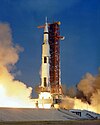Saturn V-3
 | |
| Function | orbital launch vehicle |
|---|---|
| Country of origin | United States |
| Size | |
| Height | 121 m (397 ft) |
| Diameter | 10 m (33 ft) |
| Mass | 3,664,570 kg (8,078,990 lb) |
| Stages | 3 |
| Capacity | |
| Payload to LEO | |
| Mass | 160,400 kg (353,600 lb) |
| Launch history | |
| Status | Proposal |
| First stage – MS-IC-1 | |
| Powered by | 5 F-1A |
| Maximum thrust | 45.95 MN (10,330,000 lbf) |
| Burn time | 158 seconds |
| Propellant | RP-1 / LOX |
| Second stage – MS-II-2 | |
| Powered by | 5 HG-3 |
| Maximum thrust | 7 MN (1,600,000 lbf) |
| Burn time | 324 seconds |
| Propellant | LH2 / LOX |
| Third stage – MS-IVB-2 | |
| Powered by | 1 HG-3 |
| Maximum thrust | 1.4 MN (310,000 lbf) |
| Burn time | 489 seconds |
| Propellant | LH2 / LOX |
The Saturn V-3,[1] also known as the Saturn MLV 5-3,[2][3] was a conceptual heavy-lift launch vehicle that would have utilized new engines and new stages that were never used on the original Saturn V. The Saturn V-3 was studied by the NASA Marshall Space Flight Center in 1965.[2]
The first stage, called MS-IC-1, was to have used new F-1 engines designated F-1A which utilized a pump-fed design, an anticipated 20% additional thrust, and a six-second improvement in specific impulse on an F-1, with the first stage stretched 20 feet.[2]
The second and third stages, MS-II-2 and MS-IVB-2, were proposed to use new HG-3 engines in place of the J-2 engines,[2] but were never used, although the HG-3 led to the development of the Space Shuttle Main Engine.[citation needed]
The V-3 booster was one of six Saturn MLV designs that never flew, but if these vehicles had been manufactured, they could possibly have been used for the Apollo Applications Program, Manned Orbiting Research Laboratory, Mars fly-by and Mars landing missions in the 1970s and 1980s.[3]
References
[edit]This article includes a list of references, related reading, or external links, but its sources remain unclear because it lacks inline citations. (September 2011) |
- Lowther, Scott, Saturn: Development, Details, Derivatives and Descendants
- Saturn V Improvement Study, Final report, NASA Contract NAS8-11359.
- ^ TECHNICAL MEMORANDUM X - 53252 - MODIFIED LAUNCH VEHICLE (MLV) SATURN V IMPROVEMENT STUDY COMPOSITE SUMMARY REPORT (PDF). Advanced Studies Office, George C. Marshall Space Flight Center. July 2, 1965. p. 5.
{{cite book}}: CS1 maint: date and year (link) - ^ a b c d "Saturn MLV-V-3". www.astronautix.com. Retrieved 2024-02-03.
- ^ a b Turner, Martin J. L. (2004-01-09). Expedition Mars. Springer Science & Business Media. p. 51. ISBN 978-1-85233-735-3.

